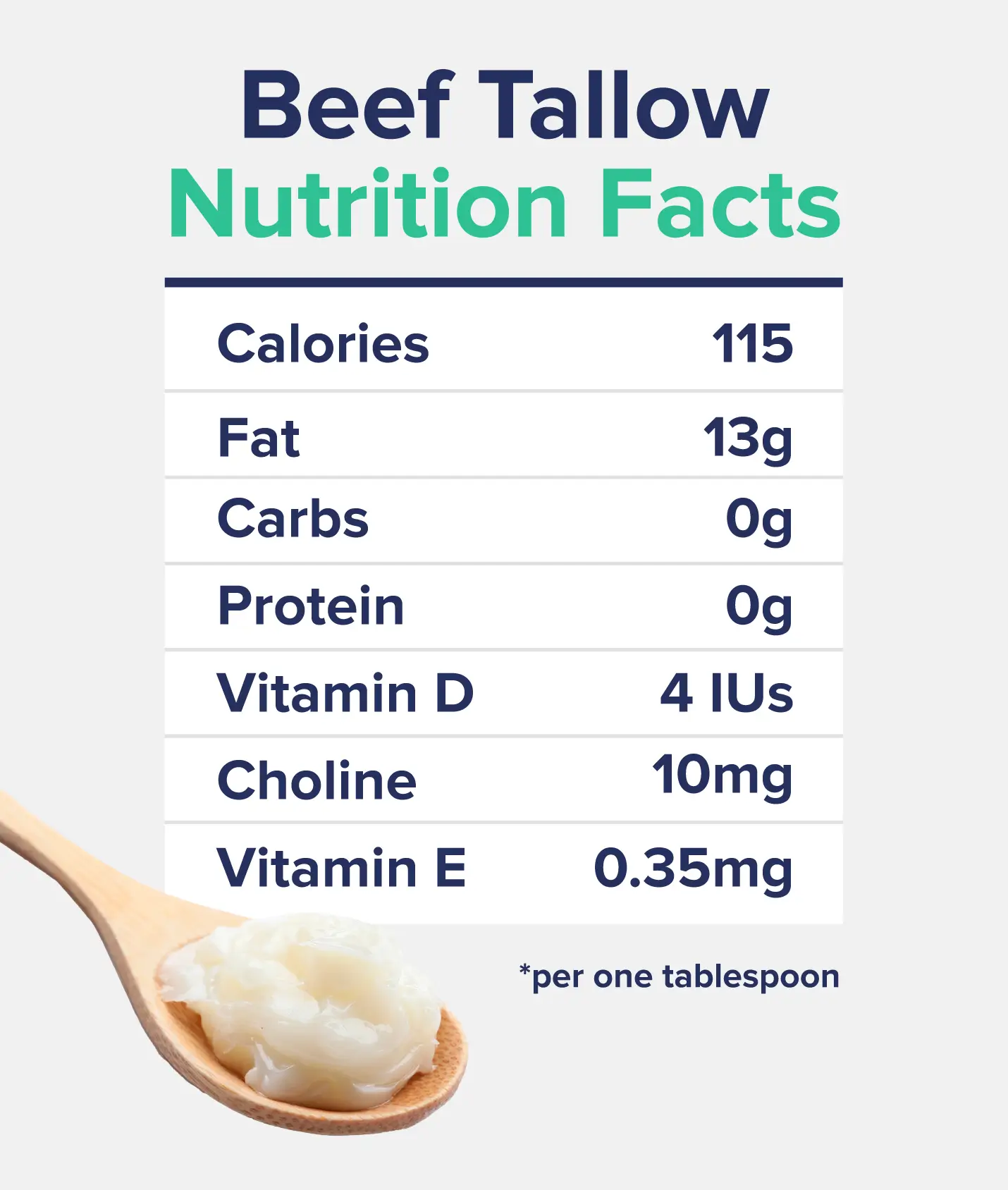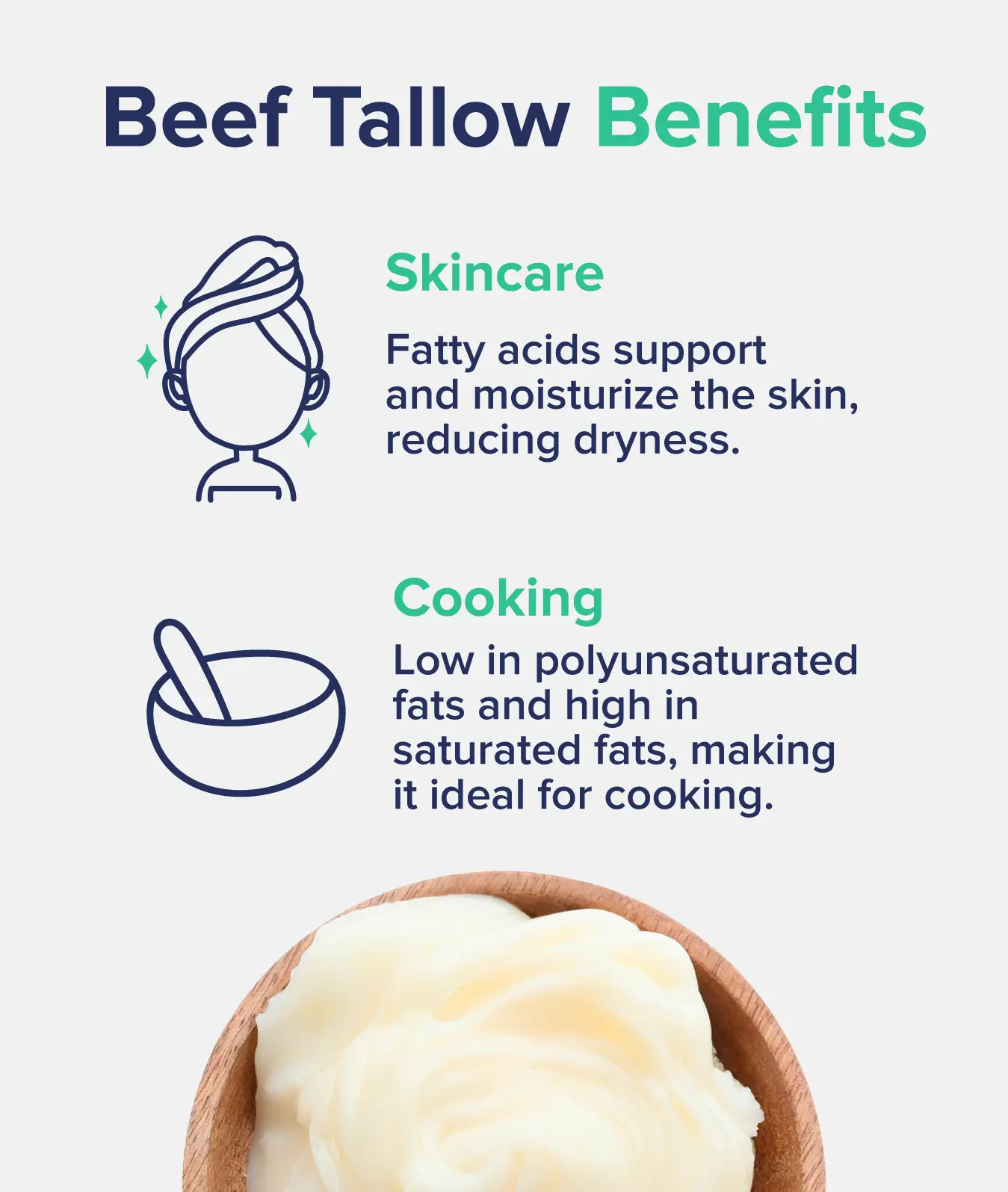Talk to a Registered Dietitian and use INSIDER20 for 20% off!
Talk to a real Dietitian for only $99: Schedule Now
This post contains links through which we may earn a small commission should you make a purchase from a brand. This in no way affects our ability to objectively critique the products and brands we review.
Evidence Based Research To fulfill our commitment to bringing our audience accurate and insightful content, our expert writers and medical reviewers rely on carefully curated research.
Read Our Editorial Policy
Once used regularly by our great-grandmothers as a cooking fat, beef tallow fell out of grace in the mid-20th century as industrialized vegetable oils were popularized—but it’s recently had a comeback, re-entering the scene as the newest darling in the skincare world.
While rubbing your face with rendered beef fat certainly sounds odd, it turns out that it may lead to several skin-related benefits—but it’s not for everyone, as we’ll see later in this article.
Plus, beef tallow is as versatile as a fat can be—you can find it both on your bathroom counter and in the kitchen.
But what exactly is beef tallow? Let’s take a closer look at the benefits of beef tallow and why everyone on your TikTok For You Page is currently adding it to their 12-step skincare routine.
Skip forums—get answers tailored to you in 45 minutes.
Skip forums—get answers tailored to you in 45 minutes.

Back before we had entire grocery store aisles full of cooking oils to choose from, homemade tallow had a myriad of household uses, including candles, soap, skin salves, frying food, and adding flavor to cooked dishes.
Now, beef tallow is being embraced by people looking to steer away from industrialized oils and go back to more traditional ingredients.
While the term “tallow” is commonly referenced as being from cows, it can also be derived from other ruminant animals, like sheep, bison, and lamb.
Beef tallow is made by rendering beef suet—the hard, white fat surrounding a cow’s organs, especially the kidneys—which involves gently heating it to separate the beef fat from any muscle or connective tissue.
The result is tallow, a pure beef fat that is solid at room temperature (similar to butter).
Although it’s made from beef (or another animal), tallow does not taste beefy or meaty—rather, it has a mild flavor with a rich fatty texture.

One tablespoon of beef tallow contains:
Some of the prominent fats found in beef tallow include:
Beef fat also contains small amounts of palmitoleic acid, an omega-7 unsaturated fat also found in macadamia nuts and sea buckthorn oil.
Overall, grass-fed beef tallow is comprised of approximately 50% saturated fat, 47% monounsaturated fat, and 3% polyunsaturated fat.
Tallow from grass-fed cows has more health benefits compared to grain-fed, factory-farmed cows due to alterations in their fatty acid profiles that come from allowing the cows to eat grass and roam freely, using their muscles more and leading to healthier fat composition.
An analysis done by the Weston A. Price Foundation found that, compared to tallow from grain-fed cows, grass-fed beef fat contains:
Beef tallow certainly has a wide range of benefits, including high-heat cooking, baking, soothing dry skin, and sealing in skin moisture.
Traditionally, beef tallow was used in pemmican, a Native American staple of beef tallow, dried meat, and dried berries, and has been used widely in households throughout history for both cooking and skin care. Let’s take a closer look at the uses and benefits of tallow.

So, why are people suddenly rubbing beef tallow on their faces? Well, it comes down to that fatty acid profile again.
Beef tallow is rich in several fatty acids that can support the skin’s lipid barrier, keeping the skin moisturized and reducing dryness.
These fats include stearic acid, oleic acid, and palmitic acid, which may also support the skin’s ability to heal and act as an emollient, covering the skin with a protective film to trap in moisture.
It’s also thought to be compatible with human skin because its fatty acid profile is similar to sebum, the natural oils produced by our skin.
The omega-3s and CLA in beef tallow provide anti-inflammatory properties, which may improve symptoms related to eczema, psoriasis, or rashes.
However, dermatologists caution that beef tallow is not FDA-approved in skincare due to a small but real risk of bovine spongiform encephalopathy (mad cow disease).
If you do use beef tallow on your skin, choose a grass-fed, pasture-raised, and ideally small-batch beef tallow to reduce risks.
However, beef tallow is not for everyone’s skin. Just as other serums or moisturizers do not work for everybody, neither does beef tallow.
Beef tallow is likely best used by people with normal, dry, irritated, or mature skin who are not prone to breakouts.
As mentioned, beef tallow has similarities to sebum—and acne-prone people already have excess sebum production.
Plus, beef tallow is rich in myristic acid, which has a moderately high comedogenic rating—meaning, it has the potential to clog pores.
That said, some people with acne have anecdotally reported that beef tallow benefits their skin—so if you deal with breakouts, it may be a case-by-case situation of whether or not beef tallow improves or worsens your skin.
People of all skin types should patch test when trying beef tallow for skincare, which entails applying a small amount of the product to a small area of skin to watch for any adverse reactions.
Rather than using the same jar of beef tallow from your kitchen, there are several high-quality brands of beef tallow designed to be used specifically for skin.
One great option is Primally Pure Everything Balm, which includes grass-fed beef tallow, extra-virgin olive oil, emu oil, beeswax, marshmallow root, calendula flower, and essential oils. Another good choice is Vintage Tradition Beef Tallow Balm, which is an unscented balm that contains just 100% grass-fed beef tallow and cold-pressed extra virgin olive oil.
The benefits of beef tallow for cooking stem from its fatty acid profile. As it’s low in polyunsaturated fats and higher in saturated fats, beef tallow is considered a stable fat for cooking.
It has a very high smoke point of about 420ºF, meaning that it won’t smoke or burn at higher cooking temperatures, like when frying, sauteeing, or roasting.
Fats that have burned or started smoking lose their nutritional value and can have increased levels of oxidative compounds like free radicals that are harmful to health.
Conversely, tallow can be used at high temperatures (like those used for roasting or frying) without causing its chemical composition to change.
Beef tallow can also be used as a substitute for butter or shortening, as it creates a crumbly texture in pie crusts and baked goods. We recommend EPIC Grass-Fed Beef Tallow and Renderings Grass-Fed Beef Tallow for cooking, baking, and deep frying.
Beef tallow is a great choice to use as a cooking oil, as it has a high smoke point and is predominantly saturated, meaning it won’t easily lead to the creation of free radicals or other oxidative compounds. You can also use beef tallow as a substitute for shortening or butter in recipes for baked goods.
Beef tallow can also be used for skin and body care, as an ointment or salve for minor injuries, and for making candles and homemade soap.
Beef tallow and butter have relatively similar nutritional profiles, as they are both cooking fats that are predominantly saturated fat. Butter is slightly lower in calories (105 per tablespoon compared to tallow’s 115) but has more saturated fat and less monounsaturated fat.
Like tallow, butter has more nutritional value when it comes from grass-fed cows, boasting increased levels of omega-3 fats and the fat-soluble vitamins A, D, and K2 compared to butter from grain-fed cows. Tablespoon for tablespoon, grass-fed beef tallow and grass-fed butter are not too dissimilar from one another and could both be additions to a healthy diet when consumed in moderation.
When it comes to high-heat cooking methods, tallow is a better choice because it has a higher smoke point than butter (420ºF versus 400ºF).
Beef tallow is not known for being good for gut health. However, one of the fats present in tallow, conjugated linoleic acid (CLA), has shown promise for supporting gut health. That said, beef tallow probably does not contain high enough amounts of CLA to impact the gut.
Plus, saturated fat (which comprises about 50% of tallow) is thought to be harmful to the gut microbiome when consumed in high amounts. Therefore, increasing beef tallow consumption in order to get more CLA is not recommended.
It depends. Beef tallow is great for certain skin types, including those with dry, mature, or normal skin and possibly those with eczema or psoriasis. This is because beef tallow has a fatty acid profile similar to our skin oils and acts as an emollient, meaning it can seal in moisture and nourish the skin.
However, people prone to breakouts may not experience the same benefits, as beef tallow can also be pore-clogging. That said, some people with acne benefit from using beef tallow on their face, so it seems to be individual.
Beef tallow and lard are similar, but the main difference is that beef tallow comes from cows (or another ruminant animal), and lard is rendered pork fat. Both are types of rendered fat that act in the same way in the kitchen.
Lard tends to have a slightly lighter flavor (not tasting as “fatty”), but they can be used interchangeably when cooking. While lard is not known for its uses in skincare like beef tallow is, it could be used on the face and body in similar ways.